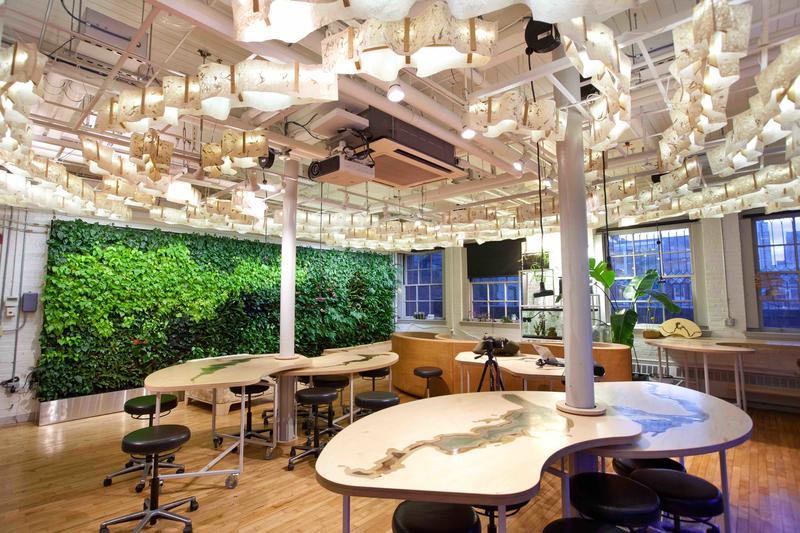“Biophilic design” is an intimidating phrase—it sounds a bit like something you’d need a Ph.D. for. But the concept is actually fairly simple, and most designers are already doing it. Biophilic design simply involves using nature in interior projects. That does include installing a living wall of plants, but it’s also as simple as creating clear sight lines for a window that overlooks a garden. So why is this relatively straightforward concept—with a confusing name—suddenly all the rage?
“Biophilic design adds another element to how we think about sustainability, and how we think about human health and well-being in sustainable spaces,” Rhode Island School of Design Nature Lab director Neal Overstrom tells Business of Home. As more and more of us live and work in urbanized spaces, disconnected from the natural world, it has increasingly become a front-of-mind problem.

Harvard biologist E.O. Wilson was simply connecting the dots between our behavior today and how it’s an adaptation for survival when he created the concept of biophilic design in the 1980s. “Biophilia,” Wilson said in 1984, “is the innately emotional affiliation of human beings to other living organisms.” He continued, “Life around us exceeds in complexity and beauty anything else humanity is ever likely to encounter.”
In some ways, the “what” of the concept is obvious—essentially, it stems from a love of place. “Biophilia is the humankind’s innate biological connection with nature,” reported environmental consulting firm Terrapin Bright Green in a 2012 paper titled “The Economics of Biophilia.” “It helps explain why crackling fires and crashing waves captivate us; why a garden view can enhance our creativity; why shadows and heights instill fascination and fear; and why animal companionship and strolling through a park have restorative, healing effects.”
Those who practice it claim that biophilic design is no longer a trend but an expectation, or even a need. What biologists describe as the “built environment”—spaces we create to live, work and be in—goes beyond LEED or WELL standards; people increasingly want green, inspiring and aesthetically pleasing features across their offices, residential, retail and hospitality spaces.
Most, if not all, of us spend more time indoors than out. But scientific evidence suggests that bringing the outdoors in—a popular phrase on magazine covers this time of year—can actually have a dramatic impact on health and wellness. For one, the presence of water increases a feeling of tranquility; having a visual connection with nature leads to a lowered heart rate and improved attentiveness. (And even if none of that interests you, consider this: Biophilic design can save money too. Terrapin claims that quality daylight in the office could save over $2,000 a year, and a view of nature for patients could save over $93 million in annual health care costs.)
 We like having plants in our homes, we like having a sense of lushness in our spaces—green, living elements.
We like having plants in our homes, we like having a sense of lushness in our spaces—green, living elements.
“As with any other design decision, it comes down to functionality, aesthetics and budget—balancing those three is what good designers do best, and biophilic design is no different,” Nathan Beckner, horticulturist and lead plant designer at Sagegreenlife, a living wall manufacturer, tells BOH. “Working these features into project plans so they have a line item, just like a sofa in a living room would, will help to remind designers to allocate budget toward it depending on the level of value they feel it will bring to that specific space. From there, similar to how you would select furniture, the options are wide open: from a well-placed succulent on the table to a custom living wall.”

The concept has deepening roots, which are even being implemented in some design education programs. In 2017, RISD received a two-year grant from the National Science Foundation to implement and test curricula that incorporated the concept. This includes emerging biomaterials, living walls, and student projects such as light fixtures comprising handcrafted paper with local invasive species mixed into the pulp, as well as tabletops for group study, which represent five different Rhode Island river systems. There are also real live jellyfish, as part of a sustainable aquatic farming system. “Science isn’t something to be intimidated by,” says Overstrom. “So many of the students that we work with here already don’t see the boundaries between art, design and science.”
“When we look to the patterns, forms and elements of nature that would be life-giving, which would be adaptive in helping us survive, we see evidence that we have an innate affinity for those that’s in our DNA,” explains Overstrom, whose expertise is in biology and landscape design. “Certain things are intuitive. We like having plants in our homes, we like having a sense of lushness in our spaces—green, living elements. There are other kinds of concepts, like ‘prospect and refuge.’ … We don’t feel as comfortable in a park if there’s a bench in the open as we do if it’s tucked back against a hedge or a space where we’re protected from behind.”





























